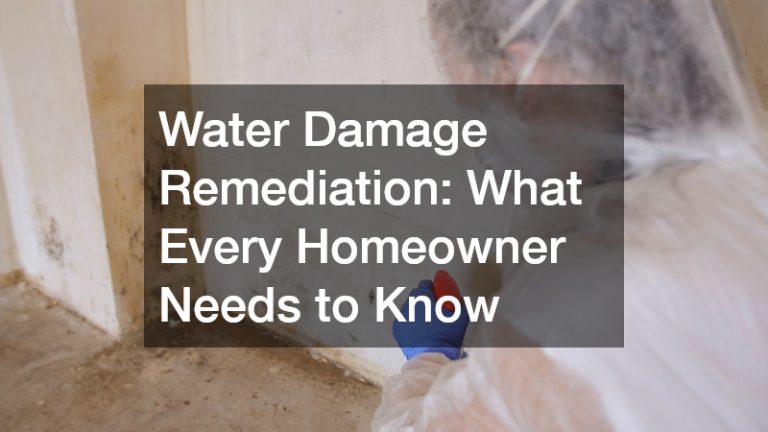Water damage remediation is a crucial aspect of maintaining a safe and healthy home environment. Left unchecked, water damage can undermine the structural integrity of your home and lead to significant financial costs. It is essential for homeowners to understand the causes, detection methods, and remediation steps to protect both their property and well-being.
Plumbing Leaks and Burst Pipes
Plumbing leaks and burst pipes are among the most common causes of water damage in homes. These issues can arise from various factors such as aging pipes, excessive water pressure, or faulty plumbing fixtures. To prevent these problems, homeowners should conduct regular inspections and consider installing pressure-reducing valves.
In colder climates, pipes can freeze and burst if not properly insulated or if the home is left unheated. It is advisable to maintain a steady indoor temperature during cold spells, even if the property is unoccupied. Additionally, regular maintenance of the plumbing system can help identify potential issues before they escalate into costly repairs.
The use of water-efficient fixtures and appliances can also minimize the risk of leaks. Routine checks and timely repairs ensure that minor plumbing issues do not develop into severe water damage. Ultimately, proactive measures and awareness can significantly reduce the likelihood of plumbing-related water damage in the home.
Natural Disasters and Weather Conditions
Natural disasters and adverse weather conditions such as floods, hurricanes, and heavy storms are significant contributors to water damage. While these events are often unpredictable, preparing your home can mitigate their impact. This includes installing storm shutters, reinforcing roofing, and ensuring flood barriers are in place.
Homeowners should remain informed about their region’s weather patterns and potential risks. By investing in proper drainage systems and landscaping, it is possible to divert water away from the home effectively. Regular maintenance of gutters and downspouts is vital in controlling water flow during heavy rainfall.
Recognizing Early Signs of Water Damage
Spotting water damage early can prevent extensive damage and costly repairs. Common visual signs include discoloration on walls and ceilings, peeling paint, or a musty odor. Homeowners should regularly inspect areas prone to moisture such as basements, attics, and bathrooms.
Structural signs that may indicate water damage include sagging floors, uneven surfaces, or weakened beams. It is vital to address these signs promptly as they may compromise the integrity of the home. Early detection allows for timely intervention, reducing both damage and repair costs.
Being vigilant and proactive in monitoring your home can help catch water damage in its initial stages. By maintaining a regular maintenance and inspection schedule, potential issues can be rectified before becoming significant problems. Awareness and timely action are key to safeguarding your property from water damage.
Initial Assessment and Documentation
The first step in water damage remediation involves a comprehensive assessment and documentation of the affected area. Homeowners should take photos and detailed notes of the damage for insurance and restoration purposes. This documentation establishes a record of the damage, which is crucial when filing an insurance claim.
Assessing the extent of the damage helps in formulating an appropriate remediation plan. This stage also involves evaluating safety risks such as electrical hazards or potential structural compromise. Thorough documentation and assessment ensure that all damage areas are addressed and adequately covered for claims and repair processes.
Water Removal and Drying Process
A crucial component of water damage remediation is the removal of water and moisture from the property. This involves using pumps, vacuums, and dehumidifiers to extract standing water and reduce humidity levels. Fast action is required to minimize the risk of mold growth and additional structural deterioration.
Specialized equipment and techniques ensure that moisture is removed from even the most challenging-to-reach areas. Homeowners may choose to hire professional restoration services for this step, as improper drying can lead to persistent issues. Professionals are equipped with industrial-grade tools and comprehensive knowledge of efficient water removal methods.
Achieving complete dryness is vital before considering repairs and renovations. Continued air circulation and monitoring of moisture levels can help maintain a dry environment post-remediation. Effective water removal not only curtails immediate damage but also prevents long-term issues such as mold infestation and residual moisture-related damage.
Restoration and Repair
The final stage of water damage remediation focuses on restoring and repairing the affected areas of the home. This includes replacing damaged materials, repairing structural elements, and ensuring the home is return to pre-damage conditions. Prioritization of repairs should be based on safety and prevention of future issues.
Restoration may require a range of tasks from repainting to major construction depending on the extent of the damage. Homeowners should work with contractors and restoration experts to ensure quality repairs that comply with building codes. Comprehensive restoration not only enhances aesthetic appeal but also ensures the home’s market value is maintained.
Incorporating preventative measures during the restoration process can help protect against future damage. Upgrading to water-resistant materials and addressing previously identified vulnerabilities can bolster resilience. Restoration ultimately restores peace, comfort, and functionality to the home, emphasizing the importance of competent remediation.
Water damage is a serious threat to the safety and value of any home, and addressing it promptly is essential. By understanding the causes, early detection methods, and remediation steps, homeowners can protect their investments and ensure a safe living environment. Proactive measures, technological advancements, and professional assessments hold the key to effective water damage prevention and management.
.

